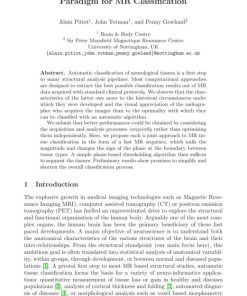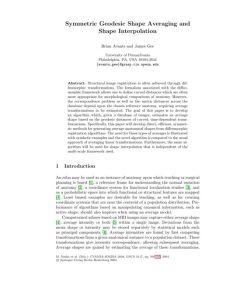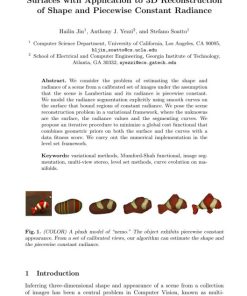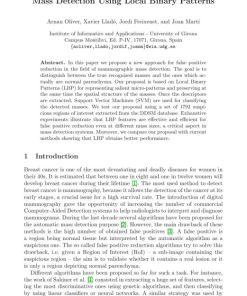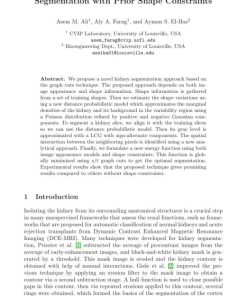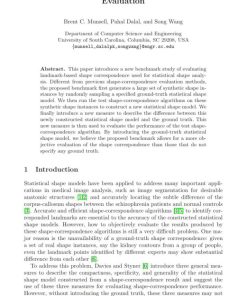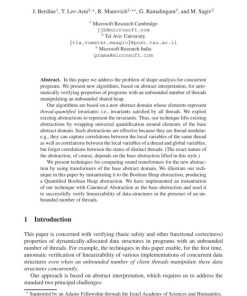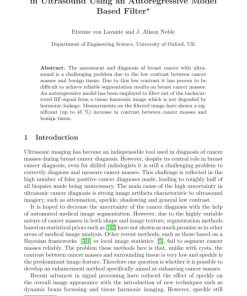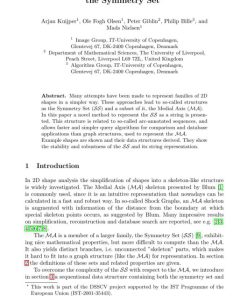Shape Analysis Using a Point Based Statistical Shape Model Built on Correspondence Probabilities 1st Edition by Heike Hufnagel, Xavier Pennec, Jan Ehrhardt, Heinz Handels, Nicholas Ayache ISBN 9783540757573
$50.00 Original price was: $50.00.$25.00Current price is: $25.00.
Authors:Heike Hufnagel, Xavier Pennec, Jan Ehrhardt, Heinz Handels; Nicholas Ayache , Tags:Medical Image Computing and Computer-Assisted Intervention – MICCAI 2007 , Author sort:Heike Hufnagel, Xavier Pennec, Jan Ehrhardt, Heinz Handels & Ayache, Nicholas , Languages:Languages:eng , Comments:Comments:Medical Image Computing and Computer-Assisted Intervention – MICCAI 2007
Shape Analysis Using a Point-Based Statistical Shape Model Built on Correspondence Probabilities 1st Edition by Heike Hufnagel, Xavier Pennec, Jan Ehrhardt, Heinz Handels, Nicholas Ayache – Ebook PDF Instant Download/Delivery. 9783540757573
Full download Shape Analysis Using a Point-Based Statistical Shape Model Built on Correspondence Probabilities 1st Edition after payment
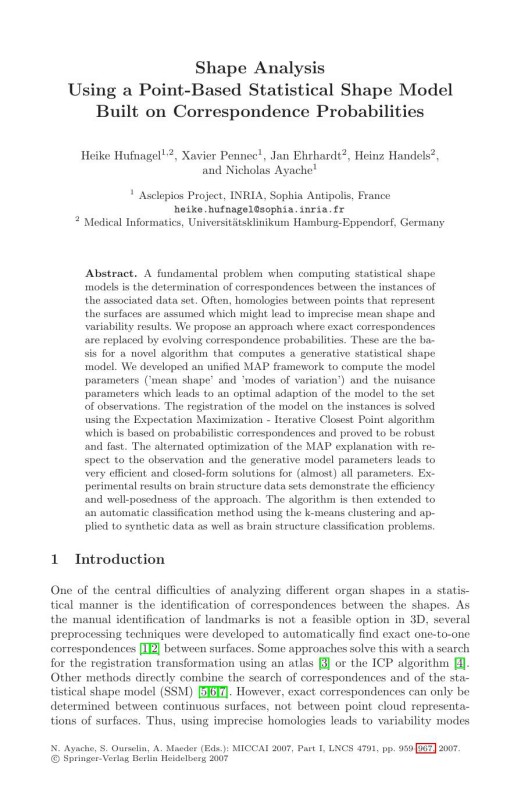
Product details:
ISBN 10:
ISBN 13: 9783540757573
Author: Heike Hufnagel, Xavier Pennec, Jan Ehrhardt, Heinz Handels, Nicholas Ayache
A fundamental problem when computing statistical shape models is the determination of correspondences between the instances of the associated data set. Often, homologies between points that represent the surfaces are assumed which might lead to imprecise mean shape and variability results. We propose an approach where exact correspondences are replaced by evolving correspondence probabilities. These are the basis for a novel algorithm that computes a generative statistical shape model. We developed an unified MAP framework to compute the model parameters (’mean shape’ and ’modes of variation’) and the nuisance parameters which leads to an optimal adaption of the model to the set of observations. The registration of the model on the instances is solved using the Expectation Maximization – Iterative Closest Point algorithm which is based on probabilistic correspondences and proved to be robust and fast. The alternated optimization of the MAP explanation with respect to the observation and the generative model parameters leads to very efficient and closed-form solutions for (almost) all parameters. Experimental results on brain structure data sets demonstrate the efficiency and well-posedness of the approach. The algorithm is then extended to an automatic classification method using the k-means clustering and applied to synthetic data as well as brain structure classification problems.
Shape Analysis Using a Point-Based Statistical Shape Model Built on Correspondence Probabilities 1st Table of contents:
-
Introduction
1.1 Motivation and Background
1.2 Importance of Shape Analysis in Computational Biology, Medicine, and Vision
1.3 Challenges in Traditional Shape Models
1.4 Role of Point-Based Statistical Shape Models in Shape Analysis
1.5 Use of Correspondence Probabilities for Robust Shape Matching
1.6 Objectives and Contributions of the Paper
1.7 Structure of the Paper -
Related Work
2.1 Overview of Statistical Shape Models
2.2 Point-Based Shape Models and Their Advantages
2.3 Shape Correspondence and Matching Techniques
2.4 Use of Probabilistic Models in Shape Analysis
2.5 Review of Existing Approaches to Shape Analysis Using Correspondence
2.6 Limitations of Current Shape Models -
Problem Formulation and Approach
3.1 Definition of Shape and Correspondence in Point-Based Models
3.2 Overview of Statistical Shape Models
3.3 Introduction to Correspondence Probabilities
3.4 Mathematical Foundations for Building the Statistical Shape Model
3.5 Probabilistic Framework for Shape Analysis
3.6 Problem Statement and Goals of the Proposed Approach -
Methodology
4.1 Data Representation: Points and Meshes for Shape Analysis
4.2 Building the Point-Based Statistical Shape Model
4.3 Estimating Correspondence Probabilities Between Shapes
4.4 Statistical Model Fitting and Shape Variability
4.5 Handling Noise and Incomplete Data in Shape Correspondence
4.6 Optimization Techniques for Probabilistic Shape Matching
4.7 Evaluation and Validation Framework for Shape Analysis -
Experimental Setup and Data Sets
5.1 Description of Data Sets Used for Shape Analysis
5.2 Shape Models in Medical Imaging, Biological Structures, and Other Domains
5.3 Preprocessing Steps for Shape Representation and Correspondence
5.4 Comparison with Existing Methods in Shape Analysis
5.5 Performance Metrics for Shape Matching and Correspondence -
Results
6.1 Accuracy of Shape Analysis Using Point-Based Models
6.2 Evaluation of Correspondence Probabilities in Shape Matching
6.3 Robustness to Noise, Deformations, and Variability
6.4 Comparison with Other Shape Analysis Techniques
6.5 Quantitative and Qualitative Results for Different Data Sets
6.6 Visualizations of Shape Correspondence and Deformations -
Discussion
7.1 Strengths and Limitations of Point-Based Statistical Shape Models
7.2 Impact of Correspondence Probabilities on Shape Matching Accuracy
7.3 Challenges in Scaling the Approach for Large Data Sets
7.4 Comparison with Traditional Mesh and Surface-Based Shape Models
7.5 Insights for Future Developments and Research Directions -
Applications
8.1 Medical Image Analysis (e.g., Organ Shape, Tumor Detection)
8.2 Geometric Modeling and Computer-Aided Design
8.3 Shape Matching in Computer Vision (Object Recognition, Tracking)
8.4 Applications in Robotics and Motion Analysis
8.5 Role of Shape Analysis in Evolutionary Biology and Morphometrics -
Conclusion
9.1 Summary of Key Contributions
9.2 Impact of Correspondence Probabilities on Robust Shape Analysis
9.3 Potential for Future Improvements and Research Directions
9.4 Final Remarks
People also search for Shape Analysis Using a Point-Based Statistical Shape Model Built on Correspondence Probabilities 1st:
shape analysis using a point-based statistical
shape analysis
shape analysis mit
shap analysis python
shap analysis explained




